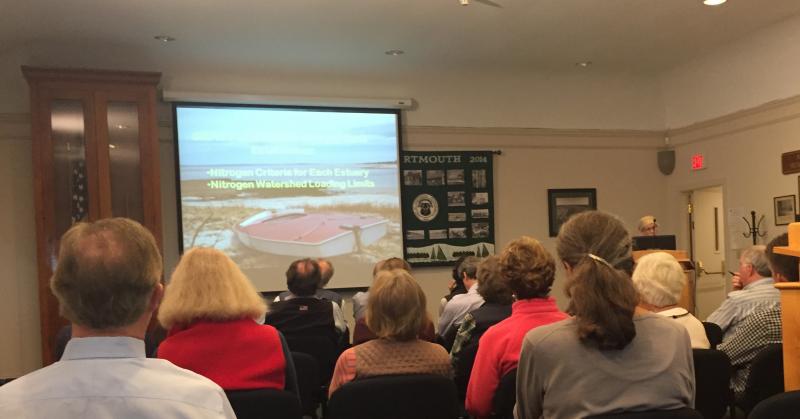State agency proposes limits to nitrogen pollution in Dartmouth waterways
High nitrogen levels could soon threaten the quality of the Slocums and Little River water systems, which connect to Buzzards Bay, but state and local officials are coming up with a plan to fight back.
The environmental risks are outlined in a recent report by the Massachusetts Department of Environmental Protection, which held a meeting to present this research and accept public comment on potential solutions at Town Hall on September 20.
High levels of nitrogen have many effects, including the loss of eelgrass beds, which are vital habitats for many creatures, increases in algae, decreases in the levels of oxygen in the water, and reductions in the diversity of the life in the water.
More dire consequences can include fish death, unpleasant odors and scum, and reductions or loss of benthic species, which live on the floor of bodies of water.
To fight back against nitrogen pollution, the state agency and UMass Dartmouth School for Marine Science and Technology researchers have calculated the maximum level of healthy nitrogen levels these bodies of water can support, called a “total maximum daily load.”
“The total maximum daily load should be thought of as the pollution budget for the water body,” explained Barbara Kickham of MassDEP.
She said that the nitrogen levels are set based on the ideal habitat for the body of water.
Establishing TMDLs is crucial to protecting these bodies of water because a TMDL is a federally set limit for pollution that can be enforced under the Clean Water Act. Because about 25 percent of the Slocums River embayment is in New Bedford, the two towns will have to work together to address this problem.
The nitrogen levels in the Slocum River watershed need to be reduced by 23.8 percent, and the levels in the Paskamansett River and Destruction Brook watersheds need to be reduced by 11.3 percent. The nitrogen levels in Little and Barney’s Joy Rivers are currently healthy but should be monitored to prevent an increase.
Some of the sources of nitrogen pollution are beyond human control, like wetlands and atmospheric deposits. But some of the major sources of nitrogen in these bodies of water can be changed, including septic systems, runoff, and fertilizer.
The main controllable sources of nitrogen pollution in these systems are septic systems and run-off from roads, sidewalks, and other surfaces that don’t allow water to penetrate to the soil below.
There are many ways to reduce the levels of nitrogen in water, but the report suggests managing stormwater runoff, sewage treatment, preventing oil pollution, and managing sanitary waste from boats.
At least two dozen people attended the MassDEP-led meeting. Most of those who commented were in support of the effort, but had concerns about how to reduce the levels, given the cost of replacing sewage systems.
“The next steps need to be that DEP submits this to the EPA as soon as possible,” Korrin Petersen of the Buzzards Bay Coalition said.
She explained that the TMDLs need to be approved by the federal Environmental Protection Agency to be enforceable. Having federal approval would also enable Dartmouth to apply for money to fund the work towards controlling nitrogen pollution.
The Massachusetts DEP is accepting comments on this report until 5 p.m. on October 31. The report is available at the department’s website or at town hall.
Comments can be submitted via email to barbara.kickham@mass.gov or by mail to Barbara Kickham, Department of Environmental Protection, Division of Watershed Management, 8 New Bond Street, Worcester, MA 01606.















